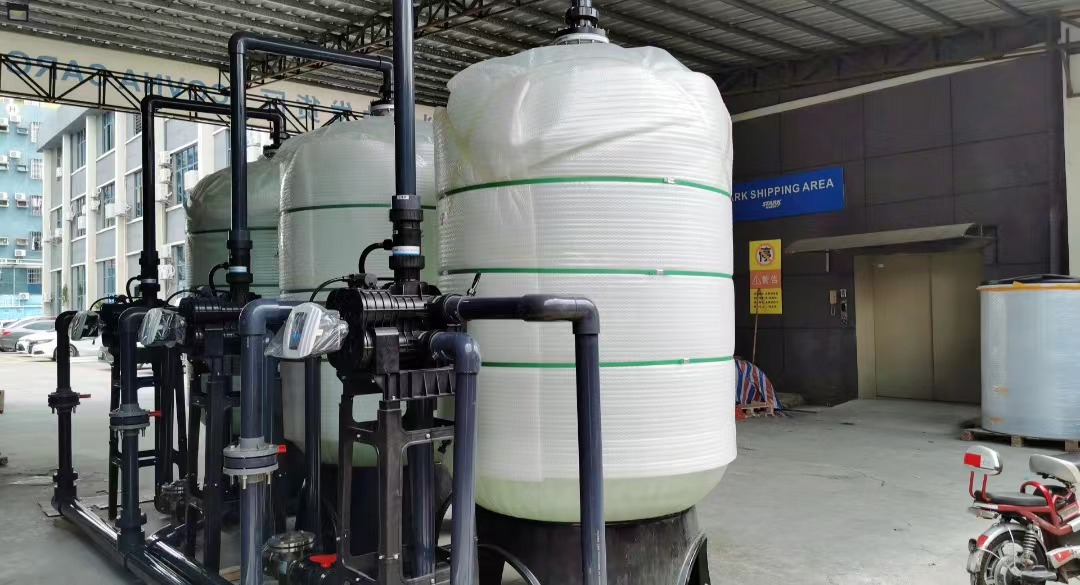01 Sep 2023
define reverse osmosis
define reverse osmosis
Reverse osmosis (RO) is a water purification process that uses a semi-permeable membrane to remove ions, molecules, and larger particles from water. It works by applying pressure to the water, forcing it through the membrane while leaving behind contaminants. This process effectively removes impurities such as dissolved salts, bacteria, viruses, and other substances, producing clean and purified water. Reverse osmosis is commonly used in various applications, including drinking water purification, desalination of seawater, wastewater treatment, and industrial processes.

Reverse osmosis (RO) is a water purification process that uses a semi-permeable membrane to remove impurities from water. Here's how it works:
1. Pre-treatment: Before entering the reverse osmosis system, the water goes through pre-treatment to remove larger particles, sediment, and chlorine. This helps prevent damage to the RO membrane.
2. Pressure application: Reverse osmosis relies on applied pressure to overcome the natural osmotic pressure and force water through the membrane. The water is pressurized using a pump to increase its pressure.
3. Semi-permeable membrane: The heart of the reverse osmosis system is the semi-permeable membrane. It has very tiny pores that allow water molecules to pass through while blocking larger particles, ions, and impurities. This membrane acts as a physical barrier, separating clean water from contaminants.
4. Filtration process: When the pressurized water is forced against the membrane, it starts to undergo a filtration process. Water molecules, being smaller than most contaminants, can pass through the membrane, leaving behind impurities such as dissolved solids, chemicals, bacteria, viruses, and other contaminants.
5. Concentrate or reject stream: As water molecules pass through the membrane, a portion of the water with the concentrated impurities, known as the concentrate or reject stream, moves away from the membrane and gets discarded. This helps maintain the effectiveness and lifespan of the membrane.
6. Permeate or product water: The purified water that passes through the membrane is called permeate or product water. It collects in a separate storage tank and is ready for use.
7. Post-treatment: After the reverse osmosis process, the permeate water may undergo post-treatment to adjust its pH level and improve taste or re-mineralization to add back essential minerals that might have been removed during the filtration process.
.jpg)
Reverse osmosis is an effective method for removing a wide range of impurities from water, providing clean and purified water for various applications like drinking, cooking, and industrial processes.
Reverse osmosis (RO) is a water purification process that uses a semi-permeable membrane to remove ions, molecules, and larger particles from water. It works by applying pressure to the water, forcing it through the membrane while leaving behind contaminants. This process effectively removes impurities such as dissolved salts, bacteria, viruses, and other substances, producing clean and purified water. Reverse osmosis is commonly used in various applications, including drinking water purification, desalination of seawater, wastewater treatment, and industrial processes.

Reverse osmosis (RO) is a water purification process that uses a semi-permeable membrane to remove impurities from water. Here's how it works:
1. Pre-treatment: Before entering the reverse osmosis system, the water goes through pre-treatment to remove larger particles, sediment, and chlorine. This helps prevent damage to the RO membrane.
2. Pressure application: Reverse osmosis relies on applied pressure to overcome the natural osmotic pressure and force water through the membrane. The water is pressurized using a pump to increase its pressure.
3. Semi-permeable membrane: The heart of the reverse osmosis system is the semi-permeable membrane. It has very tiny pores that allow water molecules to pass through while blocking larger particles, ions, and impurities. This membrane acts as a physical barrier, separating clean water from contaminants.
4. Filtration process: When the pressurized water is forced against the membrane, it starts to undergo a filtration process. Water molecules, being smaller than most contaminants, can pass through the membrane, leaving behind impurities such as dissolved solids, chemicals, bacteria, viruses, and other contaminants.
5. Concentrate or reject stream: As water molecules pass through the membrane, a portion of the water with the concentrated impurities, known as the concentrate or reject stream, moves away from the membrane and gets discarded. This helps maintain the effectiveness and lifespan of the membrane.
6. Permeate or product water: The purified water that passes through the membrane is called permeate or product water. It collects in a separate storage tank and is ready for use.
7. Post-treatment: After the reverse osmosis process, the permeate water may undergo post-treatment to adjust its pH level and improve taste or re-mineralization to add back essential minerals that might have been removed during the filtration process.
.jpg)
Reverse osmosis is an effective method for removing a wide range of impurities from water, providing clean and purified water for various applications like drinking, cooking, and industrial processes.